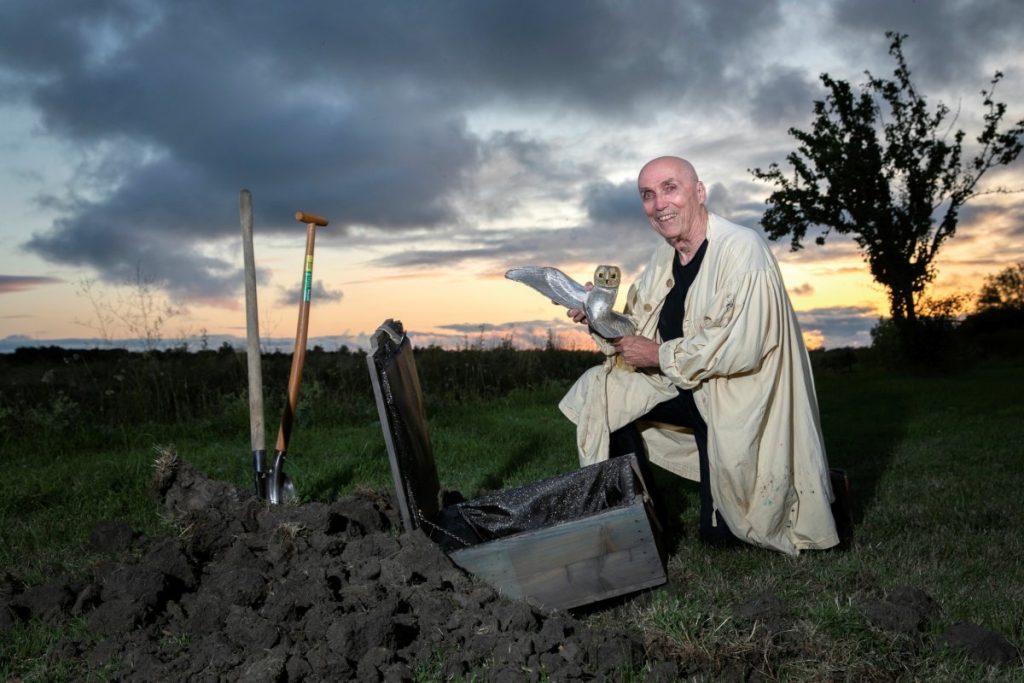Treasure hunter finally finds Golden Owl after decades
3 min read
Michel Becker photographed in Paris, France in July 30, 2023 in a reveal of the golden owl statuette. Becker became the official organizer of the treasure hunt in 2021.

Michel Becker photographed in Paris, France in July 30, 2023 in a reveal of the golden owl statuette. Becker became the official organizer of the treasure hunt in 2021.
After 31 years, the world’s longest treasure hunt has reportedly come to a thrilling conclusion with the announcement from France that the buried statuette of the golden owl has finally been found.
In a post shared on Thursday morning via the official chatline dedicated to the hunt, Michel Becker, who illustrated the original book and sculpted the buried statuette in 1993, confirmed the discovery. “We confirm that the replica of the golden owl was dug up last night, and that simultaneously a solution has been sent on the online verification system,” he wrote. “It is therefore now pointless to travel to dig at any place you believe the cache might be situated.”
However, details about the exact location of the find and the identity of the treasure hunter remain undisclosed, and Becker was unavailable for further comment.
The hunt has captivated tens of thousands of participants, generating a vast array of secondary literature in the form of books, pamphlets, and dedicated websites. The challenge was initially presented in a book by its creator, Max Valentin, who devised 11 intricate puzzles leading to a specific location in France. Upon solving these clues, hunters aimed to locate a bronze replica of the golden owl buried underground, with the ultimate prize being the actual golden original.
The value of the golden owl has been estimated at €150,000 (£126,000), as highlighted in a recent documentary by French broadcaster Canal+, which delved into the treasure hunt’s history and its impact on the community of hunters.
As news of the reported discovery spread on Thursday, the world of “chouetteurs”—the term used for the treasure hunters—was abuzz with excitement and emotion. Posts on the hunt’s Discord forum reflected a mixture of joy and disbelief. “Finally—liberated!” exclaimed one user, while another expressed, “I didn’t think I’d live to see the day.” A third chimed in, likening the relief of the find to the end of the COVID pandemic, stating, “So good when it’s over.”
Despite the general exhilaration, some participants voiced skepticism about the discovery, worrying that the cache may have been located using a metal detector. According to the rules of the hunt, the finder must prove that they successfully solved the puzzles rather than merely stumbling upon the treasure by chance.
The treasure hunt experienced significant turmoil following Valentin’s death in 2009, leading to legal disputes regarding the management of the hunt. Not all participants accepted Becker’s assumption of Valentin’s responsibilities, creating tension within the community. Becker initially did not know the exact location of the buried owl; the solution had been sealed in an envelope held by Valentin’s family.
Once legal matters were resolved, Becker reviewed the solution and traveled to the designated spot to confirm that the owl remained buried. Over recent years, he has gradually released additional clues to rekindle interest among a new generation of chouetteurs, helping to sustain the treasure hunt’s allure.
This remarkable saga, characterized by its complex puzzles, passionate community, and enduring quest, highlights the unique blend of adventure and intrigue that defines treasure hunting. With the confirmation of the golden owl’s discovery, participants are left to ponder their journeys, many eager to learn the solutions to the puzzles that have consumed their imaginations for over three decades.
As the treasure hunt reaches its conclusion, the legacy of the golden owl is sure to inspire future adventures, whether through new puzzles, fresh challenges, or perhaps even the emergence of another treasure hunt that captures the hearts of many. For now, however, the end of this legendary quest signifies not just the unearthing of a statuette but also the culmination of years of dedication and hope for all those who embarked on the journey.